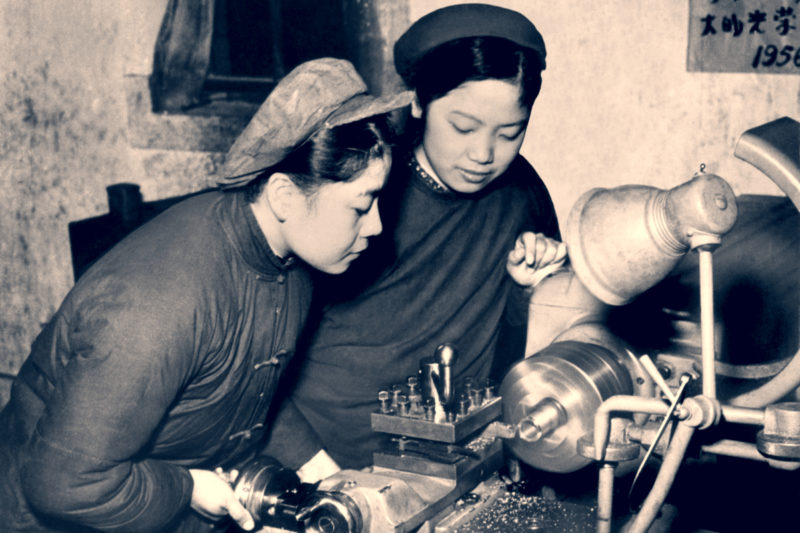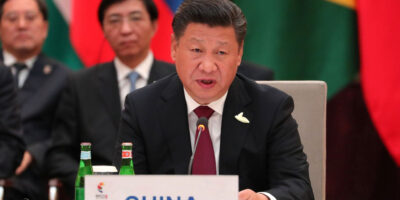The Unbearable Drabness of Command Economies

During my first year of graduate school at UCLA in the mid-1980s, I was paired with a roommate from the People’s Republic of China. Being a welcoming host, I served as his tour guide around Westwood on his first night in America, taking him out for a pizza at Numero Uno and walking through the local shops. He was amazed at the wide variety of goods we had, including a Ronald Reagan punching bag in one of the novelty stores.
“You can punch your president?” he asked. “Of course you can,” I replied and followed up with a left jab to the nose of the inflatable Gipper. (This wasn’t a partisan political statement as much as it was a poke at the ruling class in general.)
A few weeks later, in return for my helping him get acclimated to the US, my Chinese roommate presented me with a gift. He was a bit embarrassed by it, because it was all he had to give considering that he was “schooling on the cheap.” Nonetheless, I was absolutely thrilled.
“What was the gift?” you ask.
A genuine, communist-made Mao jacket, olive green in color.
The gift happened to be a piece of clothing that my roommate had brought with him as part of his regular wardrobe (though he had not yet worn it). His clothes, in general, were pretty standard: white shirts and dark slacks. I asked if he really wanted to part with this and he replied, “Oh yes. Everybody has these in China and nobody likes them.” I appreciated his honesty. (Jocularity aside, “giving someone the shirt off your back” is actually a very noble gesture.)
I was elated by this gift considering that my young scholar’s sympathies ran a bit to the socialist left. My interest in the Central American revolutions at the time, a reason for my pursuing graduate studies, only made the thrill of having a revolutionary Mao jacket all the more special.
One of the first things I noticed, though, was that the jacket had several cigarette burns in the fabric. I asked him if he had worn it before while smoking and he told me that he never tried the jacket on and cigarette burns on recently-manufactured clothing are pretty common in China. “How progressive,” I thought. “They even let their workers take smoking breaks while working! In California they make you step outside.”
While the gift of the Mao jacket reinforced the importance of graciousness as a means of bridging cultural divides, there was yet a more important lesson to be learned about the limitations of command economies when it came to providing social welfare.
As noted, my Chinese roommate mentioned that everybody in the PRC wore these Mao tunics and other standard-issue clothing. If you view all the revolutionary portraiture of Communist China, particularly during the Cultural Revolution, everybody was depicted wearing Mao jackets. Elite members of the party were always dressed in this basic uniform and society followed suit. And although Deng Xiaoping’s liberalizing reforms in the 1980s prompted a tad more variety of clothing in the PRC, fashion choices were still quite limited. Glimpse at photos taken during the Tiananmen Square protests and you will quickly notice that everybody is dressed roughly the same, with a few brave souls wearing Adidas-branded sweatshirts (probably with fewer cigarette burns). This wasn’t a society wallowing in the wildly-varied costuming of Western hippies during the 1960s and ‘70s.
And it wasn’t only China. Recall pictures of people in the Soviet Union and Eastern Europe. The photos show individuals wearing roughly the same style and color of clothing, none of it particularly vibrant. Customers shopping at their department stores didn’t have to psychologically wrestle with choosing amongst a myriad of colors, patterns, and cuts of clothing. Drab was the fashion of communism.
What accounts for this “unbearable drabness?” Several possibilities suggest themselves.
First, the answer may be simple demand. Citizens of the PRC and Soviet Union chose these similar, monochromatic clothes because that is what they liked. It isn’t surprising to find individuals mimicking the styles of their peers.
Bankers tend to dress in the same business attire – navy suits, white shirts, red ties (or a white blouse and sensible shoes). Professors wear tweed. Skateboarders don baseball caps backwards and lace up Skechers (or whatever the cool sneaker is nowadays). And since socialist nations emphasize the importance of belonging to a greater community, it shouldn’t be surprising that they would want to look alike.
Perhaps. However, Soviet citizens craved blue jeans from Western visitors. The protesters of Tiananmen Square showed an incipient desire for varied (often Western-style) clothing, and definitely not Mao jackets. My graduate roommate couldn’t wait to shop the stores of Los Angeles and diversify his wardrobe. Today, in Seattle, our visiting students from China rush to the malls to snap up any and all varieties of attire. The most diverse and wildly-fashioned clothing can be found on PRC undergraduates.
A second reason for the uniform clothing of China and the Soviet Union in the past might be political. In order to sow allegiance to the revolutionary vanguard and collective consciousness, it is important that the citizens’ clothing be sewn similarly. Call it fashion fascism, if you will. Hitler and Mussolini tried to get their populations dressed in uniform uniforms. And Kim Jong Un mandated that all North Koreans get certain styles of haircuts. What better way to show love for the national leaders than to look like them?!
There may be something to the political explanation, though economics points us to an even better account of what happens in an authoritarian fashion world: command economies cannot figure out what people really want. Bureaucrats allocating resources (including clothing) can’t easily determine what other people want. As such, everybody ends up getting what a small cadre thinks they need.
Command economics is simple. Clothing is clothing. Its purpose is to keep you sheltered from the elements. Once it accomplishes that task, no more thought needs to be put into the process. Efficiency achieved! Any effort to diversify the look of clothing is merely wasted effort that could go to meeting other important needs of the collective. Or so the calculating logic of authoritarian functionalism goes.
But it turns out that people actually have diverse preferences and tastes once their most basic needs are met. Command economies can’t figure this out because they don’t use markets and the price mechanism to foster experimentation and innovation.
Humans are the most creative species on the planet. Manatees don’t even come close to creating the great literature and gadgets we’ve dreamed up. We are constantly trying new ways to do things and to meet our pluralistic desires. But our innovation is either enhanced or limited by the economic system we inhabit.
In a free market system, profits and prices help incentivize entrepreneurs to explore new possibilities and guide them to provide what people really desire (even if those people might not know it at the moment). Profit and prices are the fuel of imagination in markets.
In command economies, you get what you get and you hope that it fits.
Imagine an artist who has a wild idea to create sweatshirts with pictures of cats shooting laser beams out of their eyes. Might anybody want that? If it was put to a central committee with the power to dictate how resources are used, a few people might get to vote and decide. If some committee members don’t like cats, those sweatshirts will not be produced for the public irrespective of whether people want cat shirts.
However, in a market economy, that artist can make a few items and offer them for sale at a price he feels is worth their effort in making them. If those sweatshirts don’t sell at that price, the world is telling you that they don’t want that product. But, on the other hand, if those sweatshirts fly off the shelves at the offered price, consumers are telling you that this was a great idea and you should produce more (and possibly raise the price to reward yourself for such stunning creativity). In a market economy, all consumers get to vote and decide.
Granted, there might be some inefficiency in this market system. Ideas that were thought to be great at the moment might make their way into bargain bins selling below the price of production or eventually be tossed into landfills. That might be wasteful, but it is only temporary waste that gets corrected quickly by self-interested individuals who don’t want to lose money. In a command economy, you can only take what is offered; the consumer has no say in what gets produced. Mistakes get deeply embroidered into society with little hope of correction.
Despite some temporary misallocation of resources in market economies, incentivized experimentation allows us to find new ways of pleasing people and making our lives better off. And, yes, laser cat sweatshirts might actually make the world a better place (at least for some folks); we know this because consumers vote with their dollars.
Over time, China slowly has opened itself to more market allocation based on prices and profits. Laser cat sweatshirts are seen in the streets of Beijing. Mao tunics are not as popular. Fortunately though, and thanks to markets, for those of you who long for the retro look, there are businesses today that produce Mao jackets with fancy dragon embroidery, perfect for all your Upper East Side socialist cocktail parties.
As for my Chinese roommate, he was so inspired by his time in a more liberalized nation, seeing what prices and profits can do, that he went on to join the American-based marchers supporting the Tiananmen protesters. The last time I heard from him was shortly after the crackdown of the protests in China. He had a pizza from Numero Uno delivered to my apartment with a note thanking me for introducing him to the freedom that America offered. The pizza had a variety of my favorite toppings.










